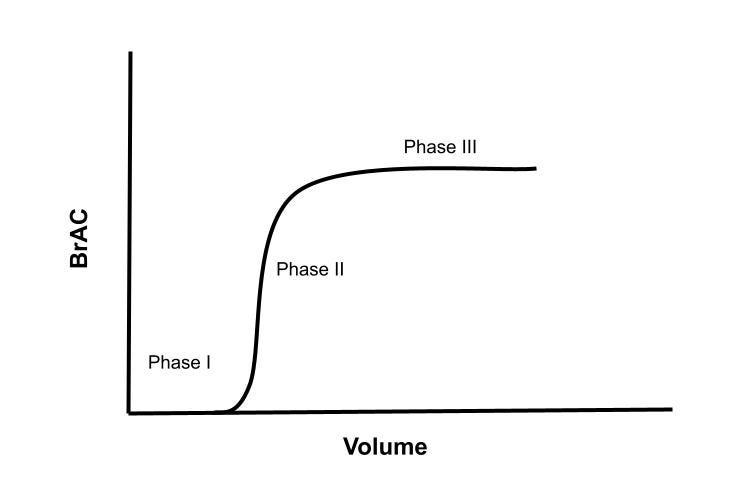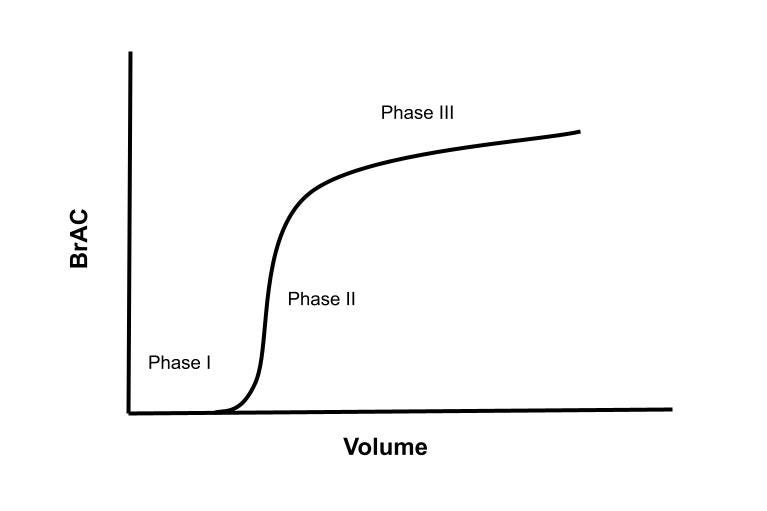The Problem of Breath Alcohol Concentration and Exhaled Volume
The Flaw in Breath Alcohol Tests: Why Exhaled Volume Matters
In forensic breath alcohol testing, there persists a naive belief that as a subject blows into a breath alcohol analyzer, breath alcohol concentration (BrAC) will quickly rise and reach a plateau, at which point the subject’s breath alcohol concentration will no longer increase [1]. This old paradigm of alcohol diffusion into the breath is frequently touted by forensic scientists in the courtroom and promulgated in training materials related to breath alcohol testing [1–4].
In reality, alveolar concentration is never reached, and the BrAC continues to rise throughout exhalation [5,6]. Jones has pointed out that a mechanistic understanding of alcohol exchange in the lungs using only Henry’s law is insufficient to explain alcohol exchange in breath [7]. In 2010, Hlastala called the simplistic model of alcohol exchange in the lungs the “old paradigm” [5]. Other mechanisms such as diffusion, perfusion, ventilation, and differential solubilities must be accounted for when describing alcohol exchange in the lungs and airways.
While Henry’s law accurately describes the exchange of alcohol in a breath alcohol simulator when used to calibrate a breath analyzer, it does not capture the complexities of the alcohol exchange in the lungs [8,9]. In particular, Henry’s law does not consider the complex dynamic interaction of alcohol diffusion in the lungs and mucous membranes of the airways leading to the lungs in vivo [10–14].
The difference between a simulated breath and an actual human breath is so pronounced that the U.S. National Bureau of Standards built a specialized three-chamber breath alcohol simulator to try to mimic the dynamic nature of human breath when testing breath alcohol analyzers [15].
Figure 2 shows Hlastala’s new paradigm of breath alcohol, which contrasts with the old paradigm. The new paradigm shows how BrAC continues to rise as the volume of exhaled air increases. Indeed, Hlastala and Anderson showed that for BrAC to reach a true plateau, a subject with a 5-liter vital capacity would need to exhale ~50 liters (a physical impossibility) [6].
The Sensitivity of BrAC to Exhaled Volume
In 2019, Anderson and Hlastala looked at 115 breath alcohol expirograms from evidentiary breath alcohol tests administered in the State of Washington to determine the influence of volume on BrAC [16]. They found that for every liter of breath provided beyond the minimum volume required of 1.5 liters, the BrAC continued to rise by 9.2% per liter.
Similarly, in 2011, Gullberg and Polissar found that BrAC was sensitive to exhalation time and volume [17]. In addition, Simpson et al. and Clatterbuck have looked at short vs. long exhalations and found long exhalations consistently exceeded short exhalations in BrAC [18,19].
The sensitivity of BrAC to volume raises the legal issue of fairness in breath alcohol testing. A subject that follows an officer's commands to “keep blowing, keep blowing…” is at a disadvantage, while the person who exhales just beyond the minimum volume will gain an advantage.
In addition, one-size-fits-all minimum volume requirements show bias against people groups with smaller forced vital capacities, such as women, Asians, and Blacks [20], who must exhale more of their available breath into the instrument, resulting in higher readings [21,22].
Attempts to Standardize Breath Alcohol Sampling Parameters
Many investigations have been conducted to standardize the sampling parameters for the breath alcohol test (BAT). Early studies looked at the effect of having subjects rebreathe into a heated bag to homogenize the breath before analyzing it [23–28]. Other efforts have included using exhaled carbon dioxide or water vapor as an internal standard to gauge when a suitable sample of breath has entered the analyzer for analysis [29–38].
Some scientists have considered using mathematical modeling to standardize BrAC [10,39–41]. For example, Anderson and Hlastala proposed a mathematical model that normalized BrAC based on the subject’s forced vital capacity [16]. By mathematically normalizing BrAC to ~50% of forced vital capacity, no subject gained or lost an advantage based on exhaled volume [42].
While manufacturers have focused on the minimum exhaled breath volume in the BAT, little attention has been paid to the maximum volume. This crucial parameter of breath alcohol sampling must receive more thought and attention to ensure an unbiased sample is analyzed [43].
Conclusion
Standardization of breath sampling parameters is needed to avoid the pitfalls of uncontrolled exhaled volume in breath alcohol testing. A forensic test should not be determined by the arbitrary length of a person’s exhalation or the capricious instructions of the officer administering the test.
In addition, a one-size-fits-all approach is biased against people with smaller lungs, as they must contribute a greater fraction of their vital capacity to the instrument.
Manufacturers and forensic scientists must consider the impact of exhaled volume in breath alcohol testing. Without consistent exhaled volume sampling parameters, reliable BrAC comparisons between instruments or jurisdictions cannot be made.
References
1. Berger A. Alcohol breath testing. BMJ. 2002;325: 1403. doi:10.1136/bmj.325.7377.1403
2. Tennessee Alco-Sensor V XL Operator Manual. Tennessee Bureau of Investigation Forensic Services Division; 2012. Available: https://downloads.tbi.tn.gov/forensic-services/breath-alcohol/BACTD002.pdf
3. About Alcohol Testing. In: CMI [Internet]. 27 Aug 2014 [cited 22 Jan 2024]. Available: https://www.alcoholtest.com/alcohol-testing/
4. Ohio Alcohol & Drug Testing Program. Intoximeters DMT Operator’s Manual. Ohio Department of Health; 2023. Available: https://odh.ohio.gov/wps/wcm/connect/gov/d548f0a3-6fd1-4b41-8c9f-939159e2194e/DMT+Operator+Manual.pdf?MOD=AJPERES&CONVERT_TO=url&CACHEID=ROOTWORKSPACE.Z18_K9I401S01H7F40QBNJU3SO1F56-d548f0a3-6fd1-4b41-8c9f-939159e2194e-oo8MzoZ
5. Hlastala MP. Paradigm shift for the alcohol breath test. J Forensic Sci. 2010;55: 451–456. doi:10.1111/j.1556-4029.2009.01269.x
6. Hlastala MP, Anderson JC. Alcohol breath test: gas exchange issues. J Appl Physiol. 2016;121: 367–375. doi:10.1152/japplphysiol.00548.2015
7. Jones AW. Physiological Aspects of Breath-Alcohol Measurement. Alcohol Drugs Driving. 1990;6: 1–25. Available: https://duiform.weebly.com/uploads/1/2/0/1/12016444/physiological_aspects_of_breath_alcohol_measurement_1990-jones.pdf
8. Schoknecht G, Barduhn B. Breath alcohol measuring equipment: principles for calibration. Blutalkohol. 1995;32: 74–82. Available: https://www.unboundmedicine.com/medline/citation/7748525/[Breath_alcohol_measuring_equipment:_principles_for_calibration].
9. Dubowski KM. Breath-Alcohol Simulators: Scientific Basis and Actual Performance. J Anal Toxicol. 1979;3: 177–182. doi:10.1093/jat/3.5.177
10. Anderson JC, Hlastala MP. Breath tests and airway gas exchange. Pulm Pharmacol Ther. 2007;20: 112–117. doi:10.1016/j.pupt.2005.12.002
11. George SC, Babb AL, Hlastala MP. Dynamics of soluble gas exchange in the airways. III. Single-exhalation breathing maneuver. J Appl Physiol. 1993;75: 2439–2449. doi:10.1152/jappl.1993.75.6.2439
12. Anderson JC, Babb AL, Hlastala MP. Modeling soluble gas exchange in the airways and alveoli. Ann Biomed Eng. 2003;31: 1402–1422. doi:10.1114/1.1630600
13. Gullberg RG, McElroy AJ. Identifying components of variability in breath alcohol analysis. J Anal Toxicol. 1992;16: 208–209. doi:10.1093/jat/16.3.208
14. Gullberg RG. Breath alcohol test precision: an in vivo vs. in vitro evaluation. Forensic Sci Int. 1989;43: 247–255. Available: https://www.ncbi.nlm.nih.gov/pubmed/2613139
15. Flores A. Breath alcohol sampling simulator (BASS) for qualification testing of breath alcohol measurement devices. U.S. Department of Commerce National Bureau of Standards; 1981 Jul. Report No.: 480-41. doi:10.6028/nbs.sp.480-41
16. Anderson JC, Hlastala MP. The alcohol breath test in practice: effects of exhaled volume. J Appl Physiol. 2019;126: 1630–1635. doi:10.1152/japplphysiol.00726.2018
17. Gullberg RG, Polissar NL. Factors contributing to the variability observed in duplicate forensic breath alcohol measurement. J Breath Res. 2011;5: 016004. doi:10.1088/1752-7155/5/1/016004
18. Simpson D, Kerby J, Kerby S. Varying Length of Expirational Blow and End Result Breath Alcohol. International Journal of Drug Testing. 2007;3.
19. Clatterbuck CC. The Impact of Systematically Varying the Duration of Breath Samples during Infrared-Based Alcohol Breath Testing. Western Michigan University. 2002. Available: https://scholarworks.wmich.edu/dissertations
20. Korotzer B, Ong S, Hansen JE. Ethnic differences in pulmonary function in healthy nonsmoking Asian-Americans and European-Americans. Am J Respir Crit Care Med. 2000;161: 1101–1108. doi:10.1164/ajrccm.161.4.9902063
21. Hlastala MP, Anderson JC. The impact of breathing pattern and lung size on the alcohol breath test. Ann Biomed Eng. 2007;35: 264–272. doi:10.1007/s10439-006-9216-3
22. Hlastala MP. The alcohol breath test—a review. J Appl Physiol. 1998;84: 401–408. doi:10.1152/jappl.1998.84.2.401
23. Forney RB, Hughes FW, Harger RN, Richards AB. Alcohol distribution in the vascular system. Concentration of orally administered alcohol in blood from various points in the vascular system, and in rebreathed air, during absorption. Q J Stud Alcohol. 1964;25: 205–217. doi:10.15288/qjsa.1964.25.205
24. Jones AW. Role of rebreathing in determination of the blood-breath ratio of expired ethanol. Journal of Applied Physiology. 1983;55: 1237–1241. doi:10.1152/jappl.1983.55.4.1237
25. Ohlsson J, Ralph DD, Mandelkorn MA, Babb AL, Hlastala MP. Accurate measurement of blood alcohol concentration with isothermal rebreathing. J Stud Alcohol. 1990;51: 6–13. doi:10.15288/jsa.1990.51.6
26. Flores A, John A. Volpe National Transportation Systems Center (U.S.). Rebreathed air as a reference for breath-alcohol testers. United States. National Highway Traffic Safety Administration. Office of Driver Performance Research; 1975 Jan. Report No.: DOT-HS-801-333. Available: https://rosap.ntl.bts.gov/view/dot/1114
27. Harger RN, Forney RB, Baker RS. Estimation of the Level of Blood Alcohol from Analysis of Breath. II. Use of Rebreathed Air. Q J Stud Alcohol. 1956;17: 1–18. doi:10.15288/qjsa.1956.17.001
28. Pinkwart C, Adrian W, Slemeyer A. On the collection of breath samples from unconscious subjects by using the rebreathing method. 8th Conference of the International Council on Alcohol, Drugs and Traffic Safety. ICADTS; 1980.
29. Lindberg L, Grubb D. Simultaneously recorded single-exhalation profiles of ethanol, water vapour and CO(2) in humans: impact of pharmacokinetic phases on ethanol airway exchange. J Breath Res. 2012;6: 036001. doi:10.1088/1752-7155/6/3/036001
30. Lindberg L, Jones AW. The advantages of standardizing exhaled breath-alcohol concentration to a reference respiratory gas-water vapor. J Breath Res. 2022;17. doi:10.1088/1752-7163/aca21b
31. Andersson AK. Improved breath alcohol analysis with use of carbon dioxide as the tracer gas. Mälardalen University Sweden. 2010. Available: https://www.diva-portal.org/smash/get/diva2:323366/FULLTEXT02.pdf
32. Lindberg L, Brauer S, Wollmer P, Goldberg L, Jones AW, Olsson SG. Breath alcohol concentration determined with a new analyzer using free exhalation predicts almost precisely the arterial blood alcohol concentration. Forensic Sci Int. 2007;168: 200–207. doi:10.1016/j.forsciint.2006.07.018
33. Harger RN, Lamb EB, Hulpieu HR. A rapid chemical test for intoxication employing breath: a new reagent for alcohol and a procedure for estimating the concentration of alcohol in the body from the ratio of alcohol to carbon dioxide in the breath. JAMA. 1938;110: 779–785. doi:10.1001/jama.1938.02790110005002
34. Andersson AK, Hök B, Karlsson A, Pettersson H. Unobtrusive breath testing. International Conference on Alcohol, Drugs, and Traffic Safety. ICADTS; 2013. pp. 25–28.
35. Jonsson A, Hök B, Andersson L, Hedenstierna G. Methodology investigation of expirograms for enabling contact free breath alcohol analysis. J Breath Res. 2009;3: 036002. doi:10.1088/1752-7155/3/3/036002
36. Kaisdotter Andersson A, Hök B, Ekström M, Hedenstierna G. Influence from breathing pattern on alcohol and tracer gas expirograms--implications for alcolock use. Forensic Sci Int. 2011;206: 52–57. doi:10.1016/j.forsciint.2010.06.016
37. Ljungblad J, Hök B, Pettersson H. Experimental proof-of-principle of in-vehicle passive breath alcohol estimation. 21st Conference of the International Council on Alcohol, Drugs and Traffic Safety. ICADTS; 2016.
38. Ljungblad J. High performance breath alcohol analysis. School of Innovation, Design and Engineering Mälardalen University. 2017. Available: https://www.diva-portal.org/smash/get/diva2:1147109/FULLTEXT05.pdf
39. Lubkin SR, Gullberg RG, Logan BK, Maini PK, Murray JD. Simple versus sophisticated models of breath alcohol exhalation profiles. Alcohol Alcohol. 1996;31: 61–67. doi:10.1093/oxfordjournals.alcalc.a008117
40. Vosk T, Emery AF. Forensic Metrology: Scientific Measurement and Inference for Lawyers, Judges, and Criminalists. CRC Press; 2014. Available: https://market.android.com/details?id=book-SzTNBQAAQBAJ
41. Gullberg RG. The mathematical analysis of breath alcohol profiles generated during breath exhalation. J Anal Toxicol. 1990;14: 358–367. doi:10.1093/jat/14.6.358
42. Hlastala MP, Anderson JC. Alcohol Breath Test: Correcting for Bias. The Champion. Mar 2020: 34–41. Available: http://pulmometric.com/PUB/Hlastala_C_2020.pdf
43. Olson A. The need for standardization of exhaled volume in breath alcohol testing. DWI Journal. 2024 [cited 17 Apr 2024]. doi:10.61874/dwij/mgqj9294



